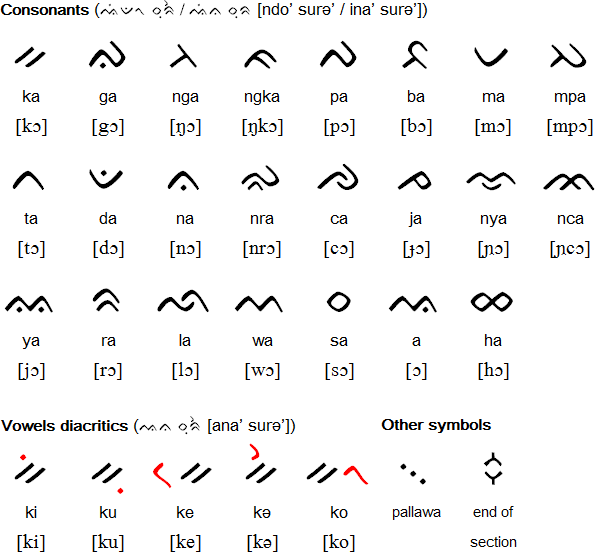Notable features
- Type of writing system: syllabic alphabet / alphasyllabary
- Direction of writing: left to right in horizontal lines
- In common with other Brahmi-derived syllabic alphabets, each consonant has an inherent vowel [a], other vowels are indicated by adding diacritics above or below a consonant.
Used to write:
Bugis or Buginese (ᨅᨔ ᨕᨘᨁᨗ), Makassarese (ᨅᨔ ᨆᨀᨔᨑ) and Mandar, Austronesian languages spoken on the Indonesian island of Sulawesi.Both scripts were once used to write laws, treaties, maps, etc in Bugis, but are now only used for marriage ceremonies. The Makasar script is still widely used to write Makasar (ᨅᨔ ᨆᨀᨔᨑ / Basa Mangkasara'), although the Latin alphabet is officially favoured.
Lontara script for Bugis
Consonants

Vowels

Sample text in the Lontara script in Bugis

Sample text in Bugis (Latin alphabet)
Sininna rupa tau ri jajiangngi rilinoe nappunnai manengngi riasengnge alebbireng . Nappunai riasengnge akkaleng, nappunai riasengnge ati marennni na sibole bolena pada sipakatau pada massalasureng.A recording of this text
Translation
All human beings are born free and equal in dignity and rights. They are endowed with reason and conscience and should act towards one another in a spirit of brotherhood.(Article 1 of the Universal Declaration of Human Rights)
Tower of Babel in Bugis and Makassar
Links
Information about Buginese, Lontara and Makassaresehttp://en.wikipedia.org/wiki/Buginese_language
http://en.wikipedia.org/wiki/Lontara
http://en.wikipedia.org/wiki/Makassarese_language
Free Lontara font
http://alibataatpandesal.com/outbox.html









.jpg)
.jpg)

.jpg)





0 comments:
Post a Comment
Note: Only a member of this blog may post a comment.